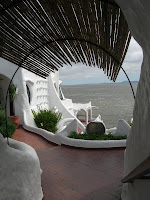write, create and share relaxed times with friends and
family, it might just look something “El Águila” which
we visited on our recent trip to Uruguay.


This intriguing structure built by Uruguayan artist/builder
Juan Torres for Natalio Michelizzi in the years 1945-48
looks out over the beautiful sandy beach near the town
of Atlántida.


Although it’s larger boat-like (or dolphin-like..
there seems to be differing ideas on the appearance)
which used to jut out below the Eagle head is now gone,
one can still climb up into the head and get a bird’s
eye view of the beach. Seems like Torres approached
the project much like I might have (or similar to
Carlos Páez Vilaró). There weren’t any set plans. He
just began!

It would have been nice to ride horseback along the
largely abandoned beach, but we settled for sand
castles and waves.
From a house like a bird to houses made by birds,
I was fascinated by all the dome mud houses
created by the Horneros (a type of “oven bird”..
probably so named because their houses look like
bread ovens.) We saw them everywhere, especially
tucked into the eves, on beams, on window sills
of houses near where our daughter lives.

Here is another one at the top of one of the many
public sculptures in Montevideo. The Hornero
placed his house to look our over the sea too!

The sculpture which the Hornero chose was probably
my favorite of all the public sculptures we saw in Uruguay.
This one, dedicated to sailors lost at sea, is located
in Punta Gorda. It looks out over La Rambla, the
long drive and walkway which stretches for miles along
the shore in Montevideo. The intertwined bronze circular
figures with protruding spines convey powerful
tragedy.


Next week El Mercado de los Artesanos and more
bird imagery!
Journey on!
































